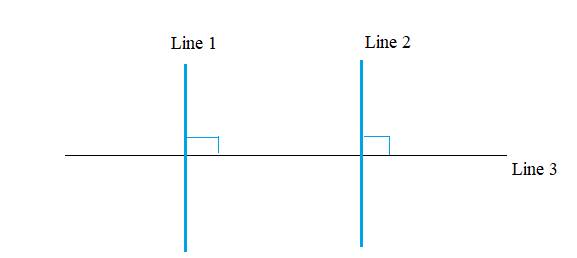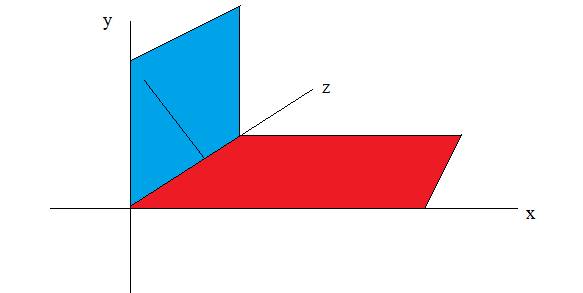
Concept explainers
a
To check whether the statement “Two lines must either intersect or be parallel” is true or false.
a
Answer to Problem 1RP
True
Explanation of Solution
Given information :
The following statement is given
“Two lines must either intersect or be parallel”
If a line is parallel, then it will never intersect each other. Therefore, the intersecting lines could not be parallel.
Hence the statement is correct that either the line can be intersecting or parallel.
b
To indicate whether the statement “In a plane, two line perpendicular to same line are parallel” is true or false
b
Answer to Problem 1RP
True
Explanation of Solution
Given information :
The following statement is given
“Two line perpendicular to same line are parallel”
In a plane, the two lines perpendicular to the same line would be parallel to each other as shown in the figure.

c
The statement “In a space, two lines perpendicular to same line are parallel” is true or false.
c
Answer to Problem 1RP
False
Explanation of Solution
Given information :
The following statement is given
“In a space, two lines perpendicular to same line are parallel”
Let us consider two non-parallel lines in a vertical plane, these both lines must be perpendicular to the horizontal plane.
Therefore, the two lines need not to be parallel, if they are perpendicular to the same line.
d
To check whether the given statement “if a line is perpendicular to plane, it is perpendicular to every line in the plane” is true or false
d
Answer to Problem 1RP
True
Explanation of Solution
Given information :
The following statement is given:
“If a line is perpendicular to plane, it is perpendicular to every line in the plane”
If a line is perpendicular to the plane, that means it will remain perpendicular to the every line in the other plane.

As we can see from the above figure, any line in the vertical plane must be perpendicular to the every line in the horizontal plane.
e
The statement “Is it possible for two planes to intersect at one point” is true or false.
e
Answer to Problem 1RP
False
Explanation of Solution
Given information :
“Is it possible for two planes to intersect at one point”
Explanation:
The planes are containing infinite no. of points, so when intersection of the planes takes place, then it intersects at infinite no. of points, therefore it can not be possible to intersect at one point.
f
The following statement “If a line is perpendicular to a line in a plane, it is perpendicular to plane” is true or false.
f
Answer to Problem 1RP
False
Explanation of Solution
Given information :
“If a line is perpendicular to a line in a plane, it is perpendicular to plane”
When line is perpendicular to the other line in the same plane, then that line can not be perpendicular to the plane. Because to be perpendicular to the plane that line must be in some other plane.
g
The following statement “Two lines perpendicular to same line are parallel” is true or false
g
Answer to Problem 1RP
False
Explanation of Solution
Given information :
“Two lines perpendicular to same line are parallel”
Explanation:
If all the lines are in the same plane, then we can say that the line which are perpendicular to the same line would be parallel.
But if the lines are not in the same plane, then it is not need to be true.
h
The statement “A
h
Answer to Problem 1RP
True
Explanation of Solution
Given information :
“ A triangle is plane figure”
A triangle is the 2D figure that means it has to be in a plane. If we go for 3D, then it becomes pyramid. Hence, we can say that the triangle is a plane figure.
i
The following statement “A line that is perpendicular to horizontal is vertical” is true or false
i
Answer to Problem 1RP
True
Explanation of Solution
Given information :
“ A line that is perpendicular to horizontal is vertical”
If a line is perpendicular to the horizontal line, then it has to be vertical. Otherwise it will not be at
j.
The following statement “Three parallel lines must be coplanar” is true or false.
j.
Answer to Problem 1RP
False
Explanation of Solution
Given information :
“ Three parallel lines must be coplanar”
It can be possible that three lines are in two different planes and they can be parallel to each other. Therefore, three lines need not to be in the same plane for becoming parallel.
k.
The statement “Every four-sided figure is plane figure” is true or false.
k.
Answer to Problem 1RP
True
Explanation of Solution
Given information :
“Every four-sided figure is plane figure”
Plane figure means that all figure is 2D or all the sides are in the same plane. Therefore, if we increase the plane, then four-sided figure would not be possible. Therefore, we can say every four-sided figure would be a plane figure.
Want to see more full solutions like this?
Chapter 6 Solutions
Geometry For Enjoyment And Challenge
Additional Math Textbook Solutions
A First Course in Probability (10th Edition)
Elementary Statistics (13th Edition)
Basic Business Statistics, Student Value Edition
Thinking Mathematically (6th Edition)
Algebra and Trigonometry (6th Edition)
College Algebra with Modeling & Visualization (5th Edition)
- Which angles are complementary to each other? Select all that apply. 3 2 4 in 5 1 Z1 and 23 Z1 and 25 22 and 23 Z2 and 25 Submitarrow_forwardWhich angles are adjacent to each other? Select all that apply. 3 2 4 67 5 8 11 10 12 12 9 27 and 28 Z9 and 12 Z3 and 24 Z10 and Z11arrow_forwardIf the arc length of NMP is 11π, what is the length of MNP expressed in terms of πT? M N 5 44% ○ A. 54π OB. 108π P О с. 103 18 O D. 108arrow_forward
- Given: Circle J 2 What is the value of y? A. 38 C. 68 B. 50 D. 92arrow_forwardFind the surface area of the regular pyramid. yd2arrow_forward5:00 PM Sat May 3 deltamath.com DeltaMath Given: ABBC and D is the midpoint of AC. Prove: ABD ≈ ACBD. ← Back to Home Deltamath Regents Review Week 3 Due: May 9 at 8:00 PM Grade: 97% Step Statement AB ≈ BC Reason 1 Given D is the midpoint of AC 2 BD BD 3 ADDC Calculating Volume (Mixed) Volume of Oblique Solids Volume, Density, and Unit 5 4 AABC is an isosceles triangle ZAZC Conversions (Level 1) Triangle Congruence Criteria try ZAD =/ DC Basic Triangle Proofs (Congruence Only - No CPCTC) Triangle Proofs (Reasons Only) Calculator Aseret Martinez Domi... Log Out Reflexive Property A midpoint divides a segment into two congruent segments The triangle has two congruent sides In a triangle, angles opposite of congruent sides are congruent An angle bisector divides an angle into two congruent angles B * A Ꭰ Note: the segment AC is a straight segment. 86%arrow_forward
- LANDMARKS Stonehenge is a British landmark made of huge stones arranged in a circular pattern that reflects the movements of Earth and the moon. The diagram shows that the angle formed by the north/south axis and the line aligned from the station stone to the northmost moonrise position measures 23.5°. a. Find measure of arc BC. b. Is arc ABC semicircle? Explain. c. If the circle measures about 100 feet across, approximately how far would you walk around the circle from point B to point sarsen circle B station stone trilithons horseshoe 71° 23.5° farthest north moonrise Sarrow_forwardfind the value of each variablearrow_forwardName: Date: Bell: Unit 11: Volume & Surface Area Homework 2: Area of Sectors Directions: Find the area of each shaded sector. Round to the hundredths place. 1. GH 11 in 2. KL 20 ft H F 64 G L 119 M K 3. BA 6.5 cm 4. YZ 14.2 m B 23 X 87° Y Z 5. KL = 27.1 mm J 32 L X:360-32.1 K A-3 360 7. BD 18 cm E 136 B X=32.8 127.0 (271) A: 069.13 Amm² 19=2102.13 A-136 360.16912 A:300cm² A=96.13 6. PQ = 2.8 in P R 311° 8. WZ 5.3 km V = Z 108 W D 9. HK = 25 ft G H KO 26 X 10. SR 26 m = S 73 T R Gina Wilson (All Things Algebarrow_forward
- 538 Chapter 13 12. Given: Points E(-4, 1), F(2, 3), G(4, 9), and H(-2, 7) a. Show that EFGH is a rhombus. b. Use slopes to verify that the diagonals are perpendicular. 13. Given: Points R(-4, 5), S(-1, 9), T(7, 3) and U(4, -1) a. Show that RSTU is a rectangle. b. Use the distance formula to verify that the diagonals are congruent. 14. Given: Points N(-1, -5), O(0, 0), P(3, 2), and 2(8, 1) a. Show that NOPQ is an isosceles trapezoid. b. Show that the diagonals are congruent. Decide what special type of quadrilateral HIJK is. Then prove that your answer is correct. 15. H(0, 0) 16. H(0, 1) 17. H(7, 5) 18. H(-3, -3) I(5, 0) I(2,-3) 1(8, 3) I(-5, -6) J(7, 9) K(1, 9) J(-2, -1) K(-4, 3) J(0, -1) K(-1, 1) J(4, -5) K(6,-2) 19. Point N(3, - 4) lies on the circle x² + y² = 25. What is the slope of the (Hint: Recall Theorem 9-1.) - line that is tangent to the circle at N? 20. Point P(6, 7) lies on the circle (x + 2)² + (y − 1)² = 100. What is the slope of the line that is tangent to the circle at…arrow_forwardCan you cut the 12 glass triangles from a sheet of glass that is 4 feet by 8 feet? If so, how can it be done?arrow_forwardCan you cut 12 glass triangles from a sheet of glass that is 4 feet by 8 feet? If so, draw a diagram of how it can be done.arrow_forward
 Elementary Geometry For College Students, 7eGeometryISBN:9781337614085Author:Alexander, Daniel C.; Koeberlein, Geralyn M.Publisher:Cengage,
Elementary Geometry For College Students, 7eGeometryISBN:9781337614085Author:Alexander, Daniel C.; Koeberlein, Geralyn M.Publisher:Cengage, Elementary Geometry for College StudentsGeometryISBN:9781285195698Author:Daniel C. Alexander, Geralyn M. KoeberleinPublisher:Cengage Learning
Elementary Geometry for College StudentsGeometryISBN:9781285195698Author:Daniel C. Alexander, Geralyn M. KoeberleinPublisher:Cengage Learning

